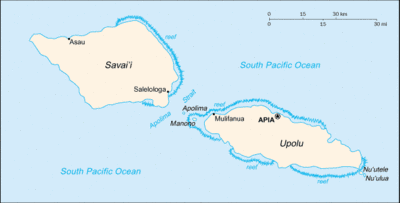Welcome to the Virtual Education Wiki ~ Open Education Wiki
Samoa
Partners situated in Samoa
Samoa in a nutshell

Samoa, officially the Independent State of Samoa (formerly known as Western Samoa and German Samoa), is a country governing the western part of the Samoan Islands in the South Pacific Ocean. The entire island group, inclusive of American Samoa, was called Navigators Islands by European explorers before the 20th century because of the Samoans' seafaring skills.
Samoa became independent from New Zealand in 1962.
The two main islands of Samoa are Upolu and Savai'i (one of the biggest islands in Polynesia).
The population of Samoa is 179,000.
The capital (and largest city) is Apia, situated on the island of Upolu.
Samoa was admitted to the United Nations on 15 December 1976.
Samoa education policy
Samoa education system
Higher education
Universities in Samoa
The National University of Samoa is the only university.
The National University of Samoa is a coeducational, publicly-supported university in Apia, Samoa. The university was established in 1984 and currently occupies a campus built in part with funding from the Government of Japan. It provides certificate, diploma, and undergraduate degree programmes, as well as technical and vocational training. Additionally, the Center of Samoan Studies at NUS offers undergraduate and graduate degrees in Samoan Studies, as well as post-graduate diplomas and certificates.
The National University of Samoa was established in 1984. Its first degree, the Bachelor of Education, was launched in 1987. A year later, the Bachelor of Arts degree was introduced. The first graduates in both programs were awarded their degrees in 1990. Soon after, the Faculty of Commerce and the Faculty of Science were established. The Samoan Health Department's School of Nursing was merged into the university in 1993 as the Faculty of Nursing, and the Western Samoa Teacher's College was merged in during 1997 as the Faculty of Education. The Institute of Samoan Studies was established in 1999. In 2006, Samoa Polytechnic merged into the university as the Institute of Technology.
Its web site is at http://www.nus.edu.ws
Polytechnics in Samoa
Note that in 2006, Samoa Polytechnic merged into the National University of Samoa as its Institute of Technology.
Higher education reform
The Bologna Process
No information.
Administration and finance
Quality assurance
Samoa HEIs in the information society
Towards the information society
Information society strategy
Virtual Campuses in HE
Interesting Virtual Campus Initiatives
None known.
Interesting Programmes
National University of Samoa Virtual Classroom
The Virtual Classroom is a course management system (CMS), or a Learning Management System (LMS) or Virtual Learning Environments (VLE). It was built entirely from free open source software & open source programming languages.
See http://www.nus.edu.ws/index.php?option=com_content&view=section&layout=blog&id=27&Itemid=121
The paper PCF5:Development of E-Learning in Education in Samoa: Issues, Challenges, Strategies and Recommendations for the Way Forward at http://directory.wikieducator.org/PCF5:Development_of_E-Learning_in_Education_in_Samoa:_Issues,_Challenges,_Strategies_and_Recommendations_for_the_Way_Forward notes:
The virtual classrooms were first established in 2003 and currently supplement on-campus instruction. The virtual classrooms are hosted within the Moodle learner management system. There are 27 classes currently hosted from 5 faculties of the Institute of Higher Education (IHE).
Current usage is mostly hosting of course notes in Word and Power point. Unfortunately the different features of the virtual classrooms are underutilised, for example the use of bulletin boards, discussion forum, student webmail for running the helpdesk, and the use of chatrooms.
Figure 1. Students using the Virtual classrooms at the National University of Samoa
A critical issue in the use of the virtual classrooms is access. With only 6 computer labs to service a student population of about 2000, access to computers and the network is a problem. A problematic factor is the stability of the infrastructure. Another major aspect which needs addressing is that of training for staff and students. Specifically for NUS, lecturers and students need to be trained in the use of Moodle, basic file management skills, email usage and web navigation.
The virtual classrooms have enhanced access and quality of education through improved access to course notes, better communication between lecturer and students and amongst students, and through facilitation of more effective management of the classroom activities.
Ongoing plans for further development and expansion of the virtual classrooms include: a) the training of teachers and students in the use of Virtual classrooms;b) training of teachers in pedagogical skills for technology integration into teaching; c) training in the use of authoring tools to develop learning objects for course content; and d) diversification of course content by use of authoring tools such as Webcom, EXE and Wikieducator
Re.ViCa Case-study
None.
Lessons learnt
References
- Ministry of Education, Sports and Culture, http://www.mesc.gov.ws
- PCF5:Development of E-Learning in Education in Samoa: Issues, Challenges, Strategies and Recommendations for the Way Forward at http://directory.wikieducator.org/PCF5:Development_of_E-Learning_in_Education_in_Samoa:_Issues,_Challenges,_Strategies_and_Recommendations_for_the_Way_Forward
- PCF5:Development of E-Learning in Education in Samoa: Issues, Challenges, Strategies and Recommendations for the Way Forward at http://directory.wikieducator.org/PCF5:Development_of_E-Learning_in_Education_in_Samoa:_Issues,_Challenges,_Strategies_and_Recommendations_for_the_Way_Forward